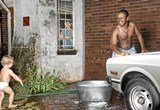
Huw Morris's photographic exhibition reflects on the ?master-servant dynamics and the desire for the other that probably existed in 1970s SA.
Huw Morris's photographic exhibition reflects on the ?master-servant dynamics and the desire for the ?other that probably existed in 1970s SA.
There is no better word than Huw Morris's own descriptor of "murky" to describe the territory of his photographic series So, this is desire?
In 11 photographs the 35-year-old photographer's narrative of love and sexual tension set in a 1970s South African home pulls at a small thread in the fabric of South Africa's domestic story and, as the viewer, you are left with the feeling of helplessly watching something unravel.
The photos tease you. Their high colour and glossy style calls to mind the super-stylised anodyne shots you see when paging through a fashion magazine. But the scenes they portray are darkly humorous and at times jarringly uncomfortable. The irony of forbidden love, of desire stirred by taboo and prohibition, is the backdrop.
In the series, Morris presents a tightly woven storyline of a white family living side by side with their black domestic servants. The domestic scenes are disturbingly familiar.
The white people in the photos are clearly "madams" and "masters", but there is a powerful sense that their privilege is more down to the way the die has been cast than to any natural order.
In their crude layout of spacious family homes with cramped servants' quarters hidden in backyards, South African homes circa the 1970s mockingly replicated the upstairs and downstairs of the British manor house.
Mockingly, because the privileges ascribed to the people in the house were mostly unrelated to them having money or a claim to the gentry. Instead, they were simply lucky enough to be born white.
Even the poorest of white people were afforded the luxury of legislated superiority.
The images are playful fiction and yet they stand in as a record of untold stories of the patterns of domestic relationships created by apartheid's proscriptions.
They are beautiful images of disturbing things that an older generation would much rather forget, of household dynamics created by racial and class politics that played themselves out in the most intimate of domestic spaces.
Apartheid, with all of its Calvinist repression, produced a funny kind of love and it's this desire for the other that Morris takes hostage in his camera lens.
I say disturbingly familiar because they are images that belong to the past, but as Morris mentions, they were inspired by the present.
"I was based in a studio near Greenside in Johannesburg for some time, which is where I shot this series and the architecture there on the houses that hadn't been modified was such a flashback for me," says Morris.
"At times I would see a maid in uniform pushing a toddler down the road–the mother walking four or five steps ahead."
The seed of an idea planted itself.
"Then I met actress Dawn Matthews on a set, and she's such a beautiful woman that it got me thinking about the potential sexual tension that would have existed in that era and the taboo of it.
"Also many of my friends were raised by nannies and present but absent mums and I wanted to explore that tension. These were the two main themes that I wanted to express but I think that as a result of doing the narrative more and more have come out and it's fairly subjective.
"A lot of people can identify things I never planned on."
By: Laurice Taitz
Article Source: Mail & Guardian
